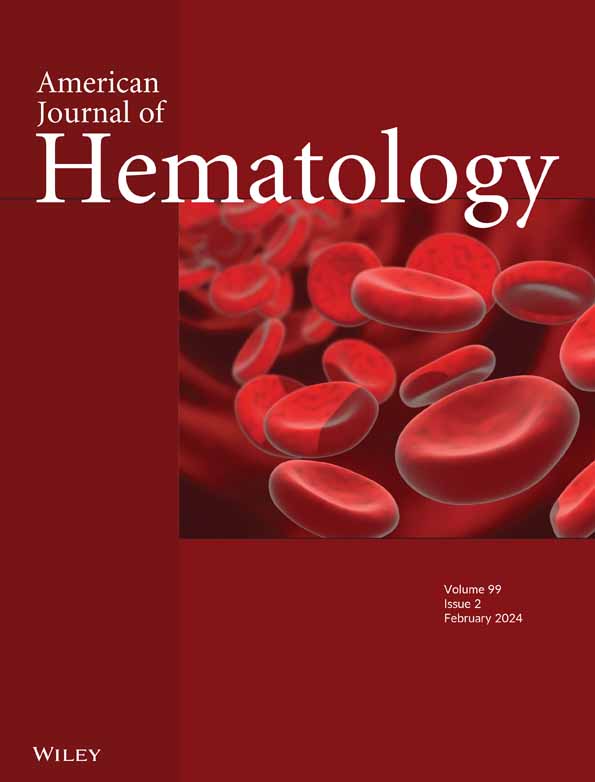轻度WAS/XLT的合并症需要终身随访并考虑最终治疗。
IF 9.9
1区 医学
Q1 HEMATOLOGY
引用次数: 0
摘要
编码WASP (Wiskott-Aldrich综合征蛋白)的基因功能突变丧失导致Wiskott-Aldrich综合征(WAS)和x连锁血小板减少症-XLT (WAS/XLT)。疾病的临床严重程度可使用WAS临床严重程度评分进行评估。通常,2岁时评分为3分或更低的患者被认为患有轻度WAS/XLT疾病。然而,在生命的前2年内得分较低的患者仍然可能出现危及生命的并发症,并且对于这些轻度WAS/XLT患者的管理尚无一致的指南。我们分析了来自法国国家原发性免疫缺陷参考中心登记的WAS/XLT患者的数据。截至2021年12月10日,已有261例患者的数据,其中170例为轻度WAS/XLT。这些患者最后一次随访时的中位年龄为15.8岁(范围2.0-60.4)。轻度was患者的40年总生存率为73%,而重度was患者为65% (p = 0.43)。在轻度WAS人群中,在造血干细胞移植或基因治疗之前,38.2%的患者在2岁后进展为WAS严重程度评分为4-5。值得注意的是,自2010年以来,无论移植的初始严重程度、移植类型和HLA相容性如何,以及诊断时的年龄,移植后中位随访时间为3.2年(0-11.5年),45例hsct中没有死亡报告。由于并发症可能在一生中发生,我们的研究支持对所有患者进行明确的治疗,包括那些轻度的患者。本文章由计算机程序翻译,如有差异,请以英文原文为准。
Comorbidities in Mild WAS/XLT Require Lifelong Follow-Up and Consideration of Definitive Treatment.
Loss of function mutations in the gene encoding WASP (Wiskott-Aldrich syndrome protein) result in Wiskott-Aldrich syndrome (WAS) and X-linked thrombocytopenia-XLT (WAS/XLT). The clinical severity of the disease can be assessed using the WAS clinical severity score. Typically, patients with a score of 3 or less at 2 years of age are considered to have mild WAS/XLT disease. However, patients with a low score in the first 2 years of life can still experience life-threatening complications, and there are no agreed guidelines for the management of these patients with mild WAS/XLT. We analyzed data on WAS/XLT patients from the French National Reference Centre for Primary Immunodeficiencies registry. At 10 December 2021, data were available for 261 patients, 170 of whom had mild WAS/XLT. The median age of these patients at last follow-up was 15.8 years (range 2.0-60.4). Overall survival at 40 years was 73% in mild WAS patients versus 65% in severe WAS patients (p = 0.43). In the mild WAS population, prior to Hematopoietic Stem Cell Transplantation or gene therapy, 38.2% of patients progressed to a WAS severity score of 4-5 after the age of 2. Remarkably, no deaths were reported in 45 HSCTs performed since 2010, regardless of initial severity, type and HLA compatibility of the transplant, and age at diagnosis, with a median follow-up of 3.2 years (0-11.5) after transplant. As complications can occur throughout life, our study supports definitive treatment for all patients when available, including those with mild forms.
求助全文
通过发布文献求助,成功后即可免费获取论文全文。
去求助
来源期刊
CiteScore
15.70
自引率
3.90%
发文量
363
审稿时长
3-6 weeks
期刊介绍:
The American Journal of Hematology offers extensive coverage of experimental and clinical aspects of blood diseases in humans and animal models. The journal publishes original contributions in both non-malignant and malignant hematological diseases, encompassing clinical and basic studies in areas such as hemostasis, thrombosis, immunology, blood banking, and stem cell biology. Clinical translational reports highlighting innovative therapeutic approaches for the diagnosis and treatment of hematological diseases are actively encouraged.The American Journal of Hematology features regular original laboratory and clinical research articles, brief research reports, critical reviews, images in hematology, as well as letters and correspondence.

 求助内容:
求助内容: 应助结果提醒方式:
应助结果提醒方式:


